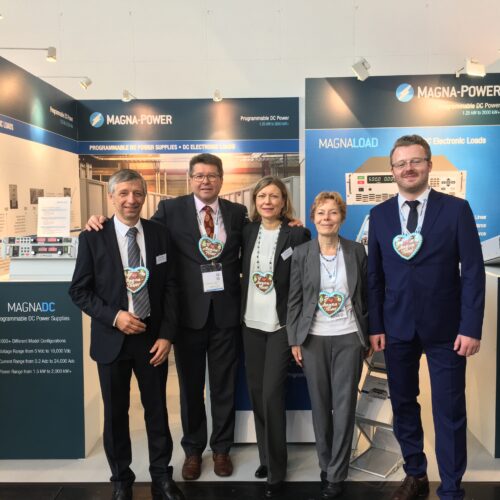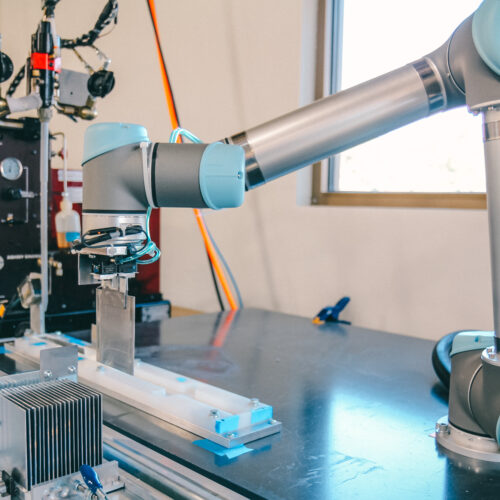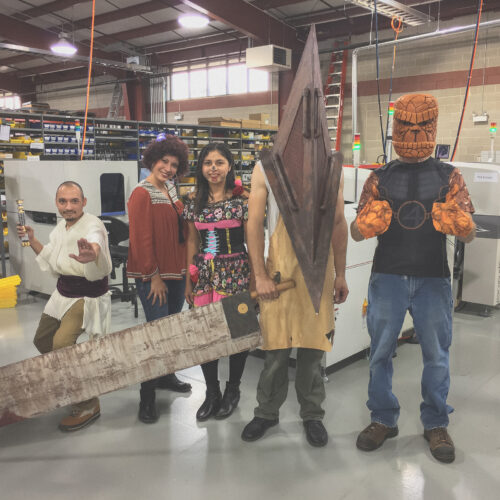Careers at Magna-Power
Want to be on an amazing team, building great products to support cutting-edge energy and power electronics applications that make a difference? Discover career opportunities at Magna-Power.
We’re looking for great talent.
At Magna-Power, we design and manufacture cutting-edge high-tech products, allowing our customers to meet their challenging power requirements. Magna-Power is a dynamic small business with high-level competence in a wide range of technological fields. Our world-class team allows us to build products of the highest capabilities and quality, with operations to transform raw materials and components into finished products.


Winner
2022 Hunterdon County Business of the Year
Winner
2016 New Jersey Manufacturer of the Year
Finalist
2016 New Jersey Family Business of the Year











World-Class Team
Magna-Power's success is attributed to dedicated team's strong working relationships, experience, continuous ambition to tackle new problems, and integration among different high-tech disciplines.
State-of-the-Art Facility
Magna-Power's manufacturing facility was built from the ground up to house the company's advanced manufacturing operations and engineering team, with continual reinvestment in facilities, equipment, and robotic automation.
Tour Magna-Power's Manufacturing OperationsOpen Positions
Magna-Power is actively hiring across many areas of the company. We are an equal opportunity employer offering competitive compensation, comprehensive health benefits and 401k savings. Choose a position listed most applicable to your background to submit an application.
Interested in applying for a position not listed or want us to keep your information on file for a future opening? Contact Magna-Power's human resources team at careers@magna-power.com.
Benefits and Perks
Generous Time Off
We believe in giving our team the time they need to truly relax and reboot.
Comprehensive Benefits
We offer health, vision, dental, life insurance, supplemental and disability benefits.
401k Savings Plan
We offer an excellent savings and investment package with company match.
Dynamic Culture
We value transparency, collaboration, and continued learning.
Educational Assistance
We’ll cover tuition costs for approved programs.
Modern Clean Facilities
State-of-the art custom designed and company-owned facilities.
Internship and Co-Op Program
Magna-Power is seeking top talent to join our Internship and Co-Op program. Our year-round program offers an unparalleled opportunity take concepts and idea from engineering, to prototypes and finally see them through to full manufacturing. Opportunities are available across all engineering functions and business operations at Magna-Power. Interns and co-ops are integral to the success of the company and, with the guidance of experienced mentors, tackle some of the hardest challenges facing the company.
Application Schedule
The following schedule defines the application acceptance dates for Magna-Power's internship and co-op program. The available internship and co-op positions will be posted under Open Positions on the date applications begin being accepted.
Spring and/or Summer
Applications accepted December 1 to February 10. Offers will be sent March 1.
Fall and/or Winter
Applications accepted May 1 to June 15. Offers will be sent July 1.
Past Intern and Co-Op Projects
Dashboard Software
Intern
Ben Goldberg • Software Intern Summer 2016
Rochester Institute of Technology (RIT)
Mentor
Grant Pitel • Chief Technology Officer
Magna-Power Electronics

Problem
Magna-Power products are make-to-order products and each unit is built up special for its customers. In addition, Magna-Power has the lowest lead time in the industry, two weeks. This makes for a fast pace work environment, where having the latest data about the order is our key to success. Magna-Power shares this data through printed reports and labels that follow the order through the factory. Soon after printing it difficult (and time consuming) to make changes to the order since that requires finding and recalling the original paper work.
Solution
MagnaDASH is custom software for collecting, analyzing, and displaying information from our company database. The the backend was written in Python using the CherryPy and hosted on an Ubuntu virtual machine. The clients are Intel Compute Sticks, which was found was the most compact solution for driving the 4K resolution televisions. The front end was programmed using Node.js, Bootstrap and Sass. The project integrates with our continuous integration so that changes in SVN automatically triggers updates to the server, rebuilding of the frontend, and resetting the many clients at the company.
Product Testing Cell
Intern
Hank Huang • Mechanical Engineering Summer Intern 2019
Rutgers University
Mentor
Scott Jones • Mechanical Engineer
Magna-Power Electronics

Problem
Magna-Power voltage and current ranges extend well beyond our competitors. With products at 10,0000 V, 6,000 A, 2,000 kW, requires a plethora of test equipment, many of it of our own design as nobody else goes this high! In addition to power supplies we make electronic loads which adds to the diversity of equipment and test routines needed. Its has become challenging to accommodate testing this diversity of products, within a limited space, and uphold our high-safety standards.
Solution
The Testing Department needed to be optimized by going vertical! Testing equipment were moved into a tall racks on wheels. This increased the density of measurement equipment per testing cell and could be rearrangement as needed. Mock ups and studies were made to ensure we could test the entire product line. We had daily communication with the Testing Department to gather feedback. Bill of materials, mechanical drawings, and electrical wiring diagrams were created so that production could build them. We leveraged our sheet metal fabrication capability to punched out custom panels for emergency stops and AC input control. Test carts were overhauled for front access, further improving Magna-Power's commitment to safety.
Online Product Configurator
Intern
Lorenzo Sanelli • Software Programming Summer Intern 2019
Hunterdon Central
Mentor
Grant Pitel • Chief Technology Officer
Magna-Power Electronics

Problem
Magna-Power offers among the widest selection of programmable DC power supplies in the world: 10,000+ configurations. Without intimate knowledge of Magna-Power's product offering, it can be difficult to determine which product configuration best fits the known customer requirement. In addition, there are many exceptions to the product offering, such as water cooling, is available only on certain product series and voltage ranges, which need to be followed when quoting a product.
Solution
The Magna-Power Product Configurator (Gen 1) was designed as a way document and present the various options, constraints, and ranges in voltage, current, and power. During the build process, a Python script grabs all the active model information from the Postgres database and exports it as a dictionary. Another python function was created to filter these results. The filter contains the various rules imposed by engineering and sales. The filter was written in Python, as that is the company's preferred language, and can be read by across teams. Transcrypt was used to convert this code into JavaScript functions. File based storage greatly simplified website integration and improved speed, as no database connection is required.
User interface was programmed using JavaScript that injected DOM elements onto the page. The fronted contains Bootstrap and CSS. Final software was also built into a Craft Module so that it could be integrated on the company website.
Real-Time Inventory System
Intern
Ben Goldberg • Software Intern Summer 2017
Rochester Institute of Technology (RIT)
Mentor
Adam Morawski • Senior Software Developer
Magna-Power Electronics

Problem
Magna-Power is a vertically integrated manufacturer which requires maintaining large inventories, kitting, and stocking pre-built assemblies. Deductions and additions to inventory were being made on a desktop PC using an open-source ERP system. The long time delay between physically issuing/stocking material and when database records were updated on the desktop was causing confusion and inventory variances.
Solution
Real-time inventory tracking and kitting. Material gets deducted as soon as it leaves the shelf during kitting. Material gets added as soon as it enters stockroom. Required hardware that made data entry fast, simple, less error prone, and portable.
A rugged Android handheld computer was selected with numeric keypad and laser bar-code scanner. A Python shell utility was created using npyscreen, terminal application framework, and hosed on an Ubuntu virtual machine. Users log into the application using SSH. This implementation allows simultaneous picking and usage, easy to program maintain, quick to navigate (hot-keys), and is cross platform.
1U Digital Front Panel
Intern
Hieu Mai • Electrical Engineering Co-Op Spring-Summer 2019
Drexel University
Mentor
Parth Desai • Senior Embedded Systems Engineer
Magna-Power Electronics

Problem
The Gen2 platform went into production Fall 2016 with MagnaLOAD, our family of electronic loads. The long-term goal was is to introduce the platform into existing and new products. The smallest form-factor product is the SL series. Its comes in 1U height (1.75") and can supply 8 kW – the highest power density on the market. Major work will be needed to fit the 3U (5.25), Gen2 front panel, into 1U. Is there new display technology that needs to be considered?
Solution
The VFD display is the single most expensive component in the product. Extensive research was needed to see if it could be replaced with newer, lower cost OLED or vertically aligned LCD. Vendors were contacted all over the world. Specifications such as view angle, brightness, burn-in, life expectancy, response time, were compared – traits expected in a rack mount supply operating for decades. Despite being the oldest technology, it excelled in each of these categories and was grandfathered into the new design.
1U Gen2 Front Panel was designed in Altium Designer, Autodesk Inventor, and AutoCAD. The 3U design was broken up into multiple boards stacked using board-to-board connectors. Stacking allowed us to cram all that technology into 1.75". Microcontroller display drivers, written in C, were updated to accommodate an additional 5th digit on the 7-segment display. A new, smaller, rubber keypad was designed along with sheet metal.
Industrial Network Connectivity
Intern
Aaron Reers • Electrical Engineering Intern Summer 2020-2021
Rensselaer Polytechnic Institute
Mentor
Parth Desai • Senior Embedded System Engineer
Magna-Power Electronics

Problem
Magna-power needed to support an array of industrial connectivity protocols so our products could communicate with production lines, automated test systems, and chemical processing equipment. There are many different protocols found in these environments while the internal company bandwidth for supporting them is limited. Protocols selected for implementation must be widely adopted, leverage the existing digital platform, and reuse code from existing communications protocols (SCPI and MagnaLINK).
Solution
Implementing Common Industrial Protocol (CIP) would allow Magna-Power to address the industrial automation market. The goal was to provide native serial Modbus and add-on Ethernet-based EtherCAT, Profinet, and EtherNet/IP.
Modbus protocol was programmed and now comes standard on ALx MagnaLOADs and DBx Accessories. The ethernet-based protocols were implemented with the help of Anybus communication modules manufactured by HMS Networks. The driver-level source code and API provided by Anybus were integrated within the existing code base. Drivers detect the type of module installed, and on startup, adapts automatically. A new communication printed circuit board (PCB) was designed to fit different Anybus modules and therefore supports multiple protocols. Each protocol was documented and included setup, configuration, and validation examples. Full details on each command was programmed to be exportable and was used to auto-generate documentation.
In addition to completing this major project, Aaron was learning Altium and supporting production by fixing PCB designs so that they could be more easily manufactured.
Inventory Library Parts Creation
Intern
Alec Rybarski • Mechanical Engineering Intern Summer 2020
Stevens Institute of Technology
Mentor
Scott Jones • Senior Mechanical Engineer
Magna-Power Electronics

Problem
Magna-Power was reluctant to make the leap to solid models due to 40 years of legacy AutoCAD parts and because equipment programs and machinist mostly work in 2D. Today, 3D modeling is the industry standard, eases design communication with production, engineering, and can be modified more quickly. Magna-Power needed to make this forward thinking change to support additive manufacturing equipment, draw more complicated shapes (rubber keypads) and program sophisticated manufacturing processes (CAM).
Solution
Successful adoption of 3D modeling required creating a mechanical library of all the Magna-Power's common parts: screws, nuts, studs, etc. The project evolved to a larger scope than anticipated because parts were described consistently, which resulted in duplicate part records. Much thought went into grouping parts, designing an internal naming system, identifying component parameters, and using those parameters to automatically create version of parts that match what is stocked. The library created will hopefully find use for next 40 years!
Production Tooling and Jig Designs
Intern
Alec Rybarski • Mechanical Engineering Intern Summer 2021
Stevens Institute of Technology
Mentor
Scott Jones • Senior Mechanical Engineer
Magna-Power Electronics

Problem
As a vertically integrated manufacturing/engineering company labor inefficiencies bubble to the surface quickly. Production report these inefficiencies as improvement tickets using our internal issue tracking system so that they can be queued up for work. Tickets are spread across multiple departments and often require additional communication and design to resolve them.
Solution
Production inefficiencies are often solved with a jig or fixture that make parts easier to process or increases the number of parts that can be processed at a time.
The Printed Circuit Board (PCB) Department reported problems with their jig for soldering a small heatsink onto diodes and PCBs. The existing jig was cumbersome and prone to breaking. The fixture was redesign by expanding the diode opening giving the assembler better access for soldering. A corner edge was added to align the diodes and heatsinks to the PCB. Binder clamps were replaced with toggle clamps to improve surface contact with soldered components and increase heat conduction.
The Testing Department wanted to consolidate all the equipment to a single rack to recover workspace and speed up testing. Alec designed custom panels and shelving needed for panel mounting measurement equipment. One custom shelf was dedicated to automated data acquisition, which need mounting locations for PCBs, power supplies, BNC jacks, etc. The task required learning how to read an electrical schematic and layout components efficiently to minimize wiring paths. The oscilloscope, which used to take up a lot of benchtop space, was mounted into the a rack with a custom panel.
Automated Test System
Intern
Logan Greif • Electrical Engineering Intern Summer 2021
Rowan University
Mentor
Valay Patel • Embedded Systems Engineer
Magna-Power Electronics

Problem
Magna-Power’s diverse product offering requires testing that is equally diverse. Presently, production operations and bill of materials adapt programmability based on customer orders; testing procedures must adapt in kind. Testing stations must be capable of testing multiple product types, such as electronics loads, power supplies, and some add-on accessories.
Solution
An Automated Test System (ATS) was created to be flexible and future-proof, since it is mostly Magna-Power’s own design. Existing power supply test procedures were evaluated to determine acquisition and interface requirements, such as the analog resolution, quantity of input/output channels, sampling speed, voltage levels, etc. Software called PiDaq was developed for a single-board-computer (SBC) to control the ATS. The SBC talked to sensors and MUXs using SPI, I2C communications, and its own GPIOs. Magna-Power’s standard test software, TestAndCal, talked to the ATS using a Web API. A python-based library was developed to wrap this API.
Logan made additional hardware improvements to the test rack. He wrote ladder logic for the programmable logic controller (PLC) to adjust voltage on the three-phase variable transformer and described the operating state of the rack with illumination patterns on the stack light. Another Python-library was created so that TestAndCal could interface with the PLC. A lot of thought went into safety, especially when TestAndCal takes control of the rack to automate tests.
Get Started Today! Learn about our career opportunities.
Career and training opportunities are available at Magna-Power. Apply for an open position or contact Magna-Power human resources.
